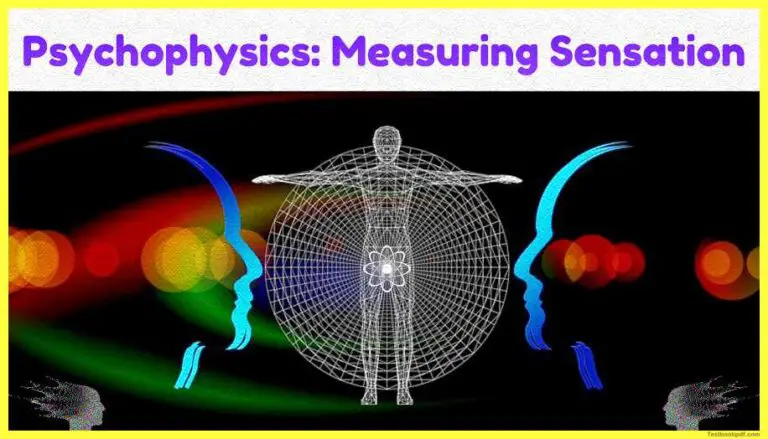Psychophysics Measuring Sensation (Pdf)
Today in this article we will give you info about Psychophysics Measuring Sensation and Whether abstract experiences are quantifiable. If yes, then how? This article primarily addresses this question and introduces you to the fascinating field of “Psychophysics”. By linking perceptual experiences to physical stimuli we can formulate our question of interest in Psychophysics. We will briefly talk about threshold determination and various methods to determine it and the laws that contributed to it.
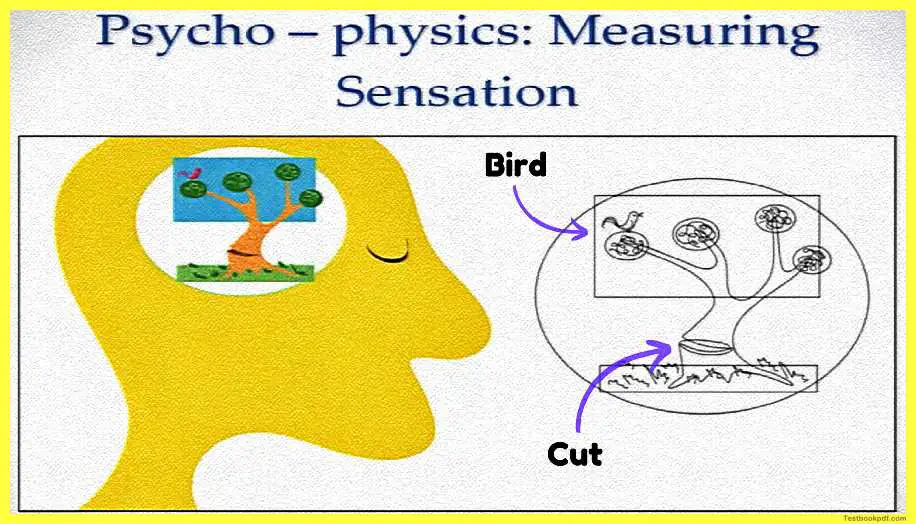
What is Psycho-Physics?
Psycho-physics is actually about measuring these different sensations by measuring the inputs that are coming from the various senses.
What is Psychophysics?
Psychophysics, as the name says, is psychology plus physics so psychophysics basically involves the determination of the psychological reaction to events that lie along a physical dimension so changes in loudness changing in brightness lightness changes in pressure-temperature those kinds of things and how we really experience them that is pretty much what the discipline of psychophysics about g boring basically claims that the introduction of these techniques, to measure the relationship between internal impressions that is the psychological experience and the external world which is the physical events that is what actually marked the onset of scientific psychology if you remember in one of the earlier articles we talked in detail about this how cognitive psychology came into being how we started really measuring what is happening in the mind space psychophysics is certainly at the forefront of the beginning of this revolution.
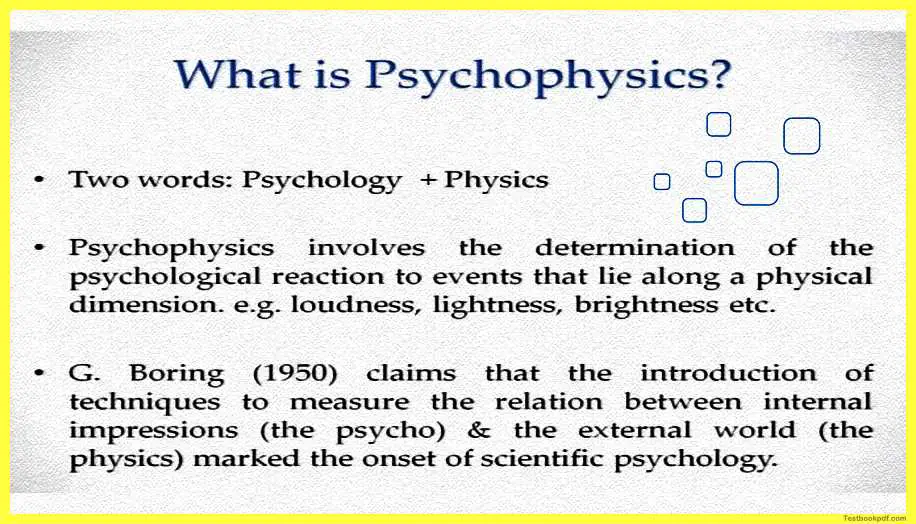
Let us talk about some basic concepts in psychophysics the problem of psychophysics actually is a bit like a paradox it requires you to objectify something which is actually a subjective experience so your experience of loudness or color etcetera are subjective experiences but we are trying to do what we are trying to do in psychophysics is to measure the subjective experiences.
What is a subjective experience?
Most basic subjective experiences are any sensation or any information that is impinging on five of your senses so measuring sensations in that sense is a rather difficult task because they’re not really open to the public measurement you cannot really measure discretely how much pain somebody is feeling or how much light you’re feeling when you lift up a particular stone or how bright you’re actually feeling the light to be sometimes you’re very tired and you actually feel that the light is too bright even though the light is the same that you’ve been using every day of your year isn’t it.
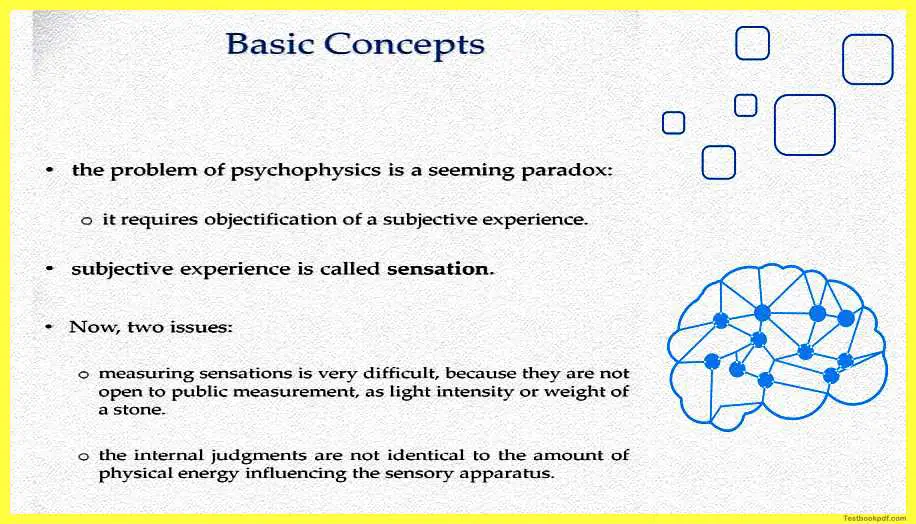
So, it is this subjective experience that we want to measure and that is what we use psychophysics for the internal judgments the ones which I was talking about are not really identical to the amount of physical energy influencing the sensory operators so it’s not like ten percent of particular physical energy in let us say light or weight or something is directly proportional to that you’re feeling ten percent weight that can actually vary quite a lot I’ll talk about that in more detail as we go ahead.
let us say take this example of a radio dial say for example if there’s a stereo in your house and you have a dial to really increase or decrease the sound or volume of this what is volume is basically a perceived loudness how loud the sound is appearing to you so you have a dial there’s a recorder it’s playing some music you have this dial you can turn this dial towards the left or towards the right to increase or decrease the loudness of music from this dial okay.
Now you’ll realize that this movement of the dial does not bear a one-to-one relation to how loud you’re actually feeling the music to be rather this dial is very cleverly calibrated so that each movement increases intensity proportional to increments in loudness so you move the dial one step and you feel that the loudness has increased you move the dial another step you feel the loudness has increased further thus doubling the volume level on the dial has to increase the physical energy by about 10 times to produce a twofold increase in loudness.
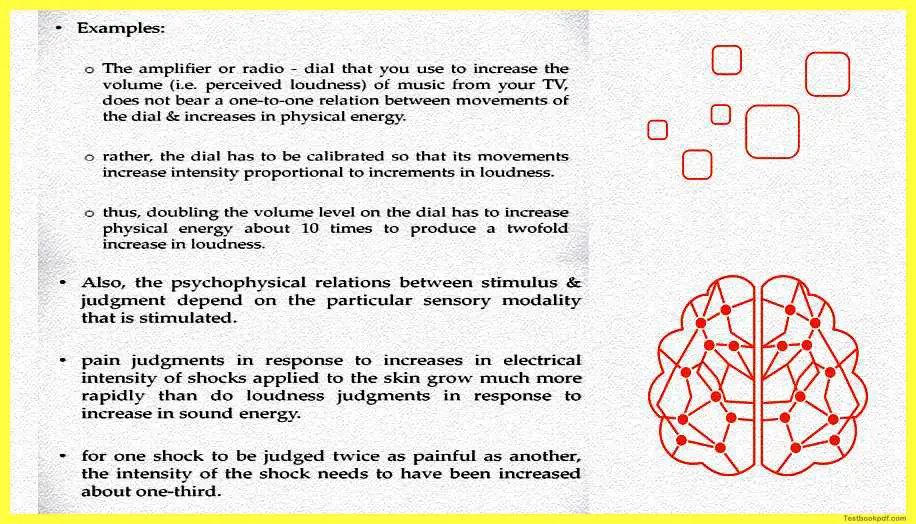
So, for you to think that something is now twice as loud does not need the physical energy to multiply just by two it rather needs the physical energy to be multiplied by 10 so that you can experience twice loudness this is what I’m talking about when I’m saying that there’s no one-to-one relationship between the amount of physical energy and corresponding psychological experience that you’re having also the psychophysical relationships between the stimulus and the judgment depend on the particular sensory modality so you might have a particular sensitivity of judgment when it comes to light or sound but you might have a very different sense of judgment when it comes to a pressure stimulus like pain etc.
Pain judgments in response to increases in the electrical intensity of shocks applied to the skin grow much more rapidly than say for example loudness judgments I told you that you have to really multiply the physical energy of sound by 10 to perceive twice the amount of loudness but you have to really multiply the electrical energy only by one by three only raise it by one-third of the time to actually make you feel twice as painful as a shock as the original time okay.

Now psychophysics basically tries to solve this problem by closely linking perceptual experience to physical stimuli what you are experiencing versus what you are getting the basic principle here is to use a physical stimulus as a reference system the stimulus characteristics are carefully and systematically manipulated and observers are asked to report how they are perceiving that particular stream.
I will come to a demonstration of that in a short while the art of psychophysics however is to formulate such a question that can get the simplest of answers so the questions are very very simple questions like can you hear the tone the person just has to say yes or no and the person says yes that the person has detected the stimulus, on the other hand, you can also ask questions like can you tell which tone which tune which songs tune I am playing then the person can say yes and then you will know that the person has identified the tone you remember we were talking about detection and identification in the research methodology article so these are two slightly different processes.
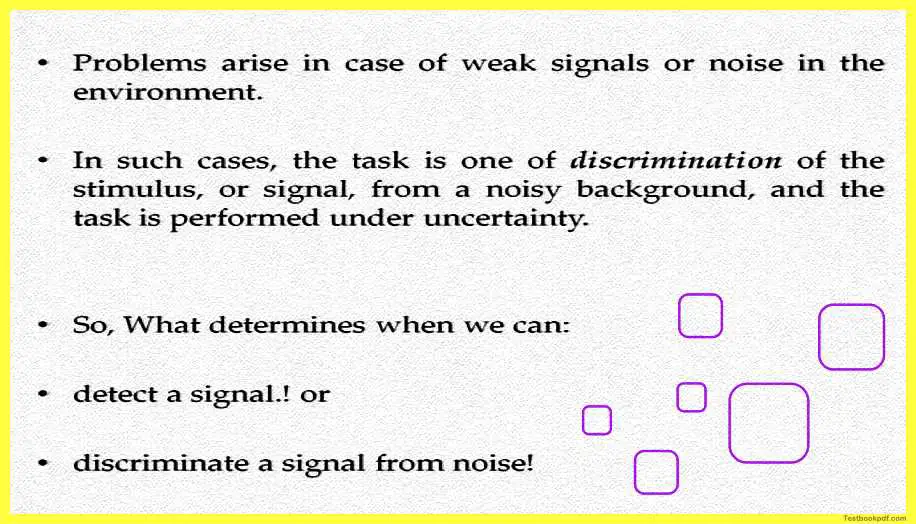
Now problems of detection and identification may rise in cases when the signal is too weak and there’s too much noise in the environment recall any party in which you are there may be one of the processions like Bharat or something and try talking to your friends or people around you and you’ll discover that it’s very difficult to really gauge what the conversation is about in the when there is so much noise in the background.
In such cases what one needs to do is one needs to do the task of discrimination so you have to actually dis discriminate the voice message that is coming from your friend from the background of the blaring noise of the band and stuff that is what is discrimination so what you have to do is you have to discriminate a signal or a stimulus from the noisy background and this task is generally performed under uncertainty there is a lot of noise you have to really pick just the signal that you intend to from this lot of background noise.
Sensory Threshold Psychology

So on what does it depend that we can detect a signal or discriminate a signal from noise what are the factors that decide one of the factors that decide whether you will be able to detect the presence of a sound or a signal is a threshold if you’re looking at this figure here you’ll notice that this just threshold that this pole vault is that this athlete has to jump over if she misses it she will not be able to go to that side I mean that’s not counted as a valid jump so this horizontal pole is that kind of threshold which really takes the person across and converts a particular jump to a valid countable jump.
It’s rather similar to what our sensory processes are like so the most basic function of any sensory system is to detect energy or changes in the environment so if there is a change in temperature you will start feeling hot or cold depending on how the changes if there is an electrical shock if there is a change in the loudness all of those kinds of things they have to change beyond a certain point for you to be able to detect it that certain point is your threshold.
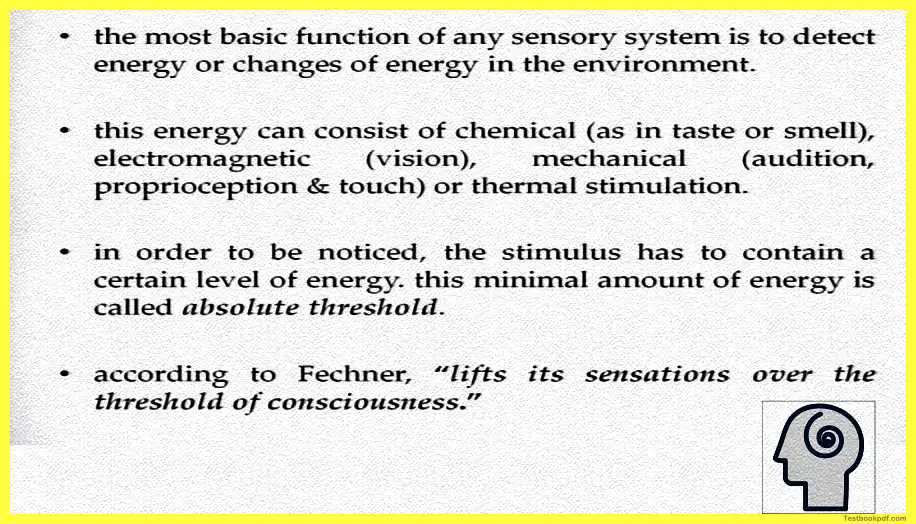
So, this change in energy can be of many times it could be chemical say for example in taste or smell how much sugar you need to add before it starts feeling sweet how much light you want to have till you start seeing something clearly or mechanical say for example how loud the sound how much strong the sound wave should be or even thermal stimulation how hot is something for you to feel hot so this is basically these are all changes energy and you have to feel them in a way beyond a particular limit.
So, that you can actually tell that now I’m feeling colder or hotter and those kinds of things that limit basically which we were talking about are your sensory threshold now in order to be noticed the stimulus has to contain a certain level of energy this minimal amount of energy in order to be noticed is absolute threshold so just the point where you can actually feel that I can detect the stimulus now is the absolute threshold factor says just enough to lift the sensation over the threshold of consciousness once you are aware of something that it is there some sensory information that is enough to say that the information has crossed its absolute threshold.
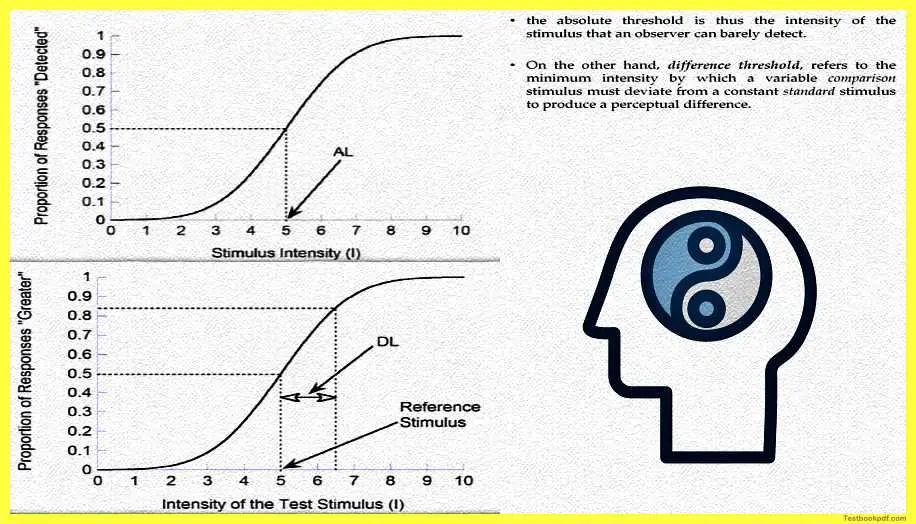
Something like this if you can see this figure here you will see as soon as the percentage of detected responses goes above 50 percent that is pretty much the time where this absolute threshold is there and on the x-axis, you can find stimulus intensity so stimulus intensity is increasing and in proportion to that the number of detected responses is plotted on the y-axis and at the point when the proportion of detected responses pass 50 percent that is chance that is a bit more than just 50 50 that is where you’ve reached your absolute threshold the absolute threshold thus is the intensity of the stimulus that the observer can barely detect on the other hand there could be something like a difference threshold what is the difference threshold refers to the minimum intensity by which a variable comparison stimulus might deviate from a particular standard stimulus to produce a perceptual difference.
So suppose you are holding two stones in your hand one of them is the standard stimulus one of them is the comparison stimulus I ask you whether the comparison stimulus is heavier or lighter than the standard stimulus at the point when you can detect that this one is just heavier or just lighter that is pretty much what is your difference threshold like.
Here you can see there is a reference stimulus and then there is a different stimulus and the difference has to be at least about 35 percent by this figure here which is basically or by actually 35 percent times when the participant can say that this is greater or heavier let us say that is where your difference threshold likes the difference is plotted horizontally by these arrows the dl symbol.
How do we determine the absolute threshold for a particular sense or a different threshold?
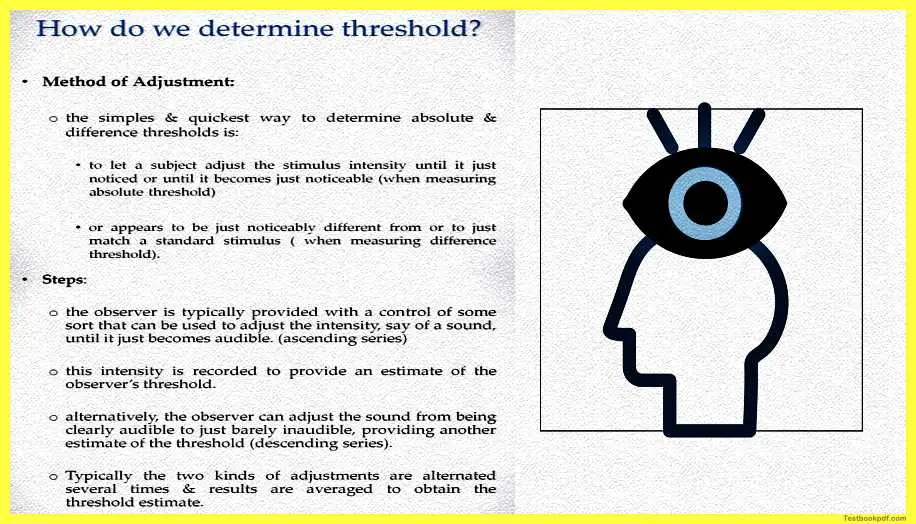
For particular sensory information, there are methods to do that the first method or the simplest method is the method of adjustment this is the simplest method in which you actually ask the participant or you ask the subject to adjust the stimulus intensity himself or herself until it is just noticed or until it becomes just noticeable.
Say for example until it becomes just noticeable will be your when you’re measuring your absolute threshold until it is just noticeably different from the comparisons from the standard stimulus is when you are actually talking about difference threshold the kind of same examples which I was talking about.
How do you do it let us go into the steps so the observer is typically provided the control of some sort and that control can be used to adjust the sound say for example if you’re talking about sound until it becomes just audible so the part the participant is changing the dial in small steps and as soon as the participant reports yes I can see it you can stop that and then you can note down that value this intensity is you do it multiple times and this average of this overall thing can be supposed to be what is your absolute threshold.
If you talking about you can also what you can do is you can actually start the observer from a higher value when the sound is very detectable and you can ask him to bring it down in small steps till it becomes not noticeable up just one step after it becomes not noticeable that is also one kind of value we will get typically these two kinds of values are alternated several times and an average is taken to get the point where you can actually barely detect something so that is how you determine over a series of trials your absolute threshold.
Methods of Limit to Determine Absolute Threshold
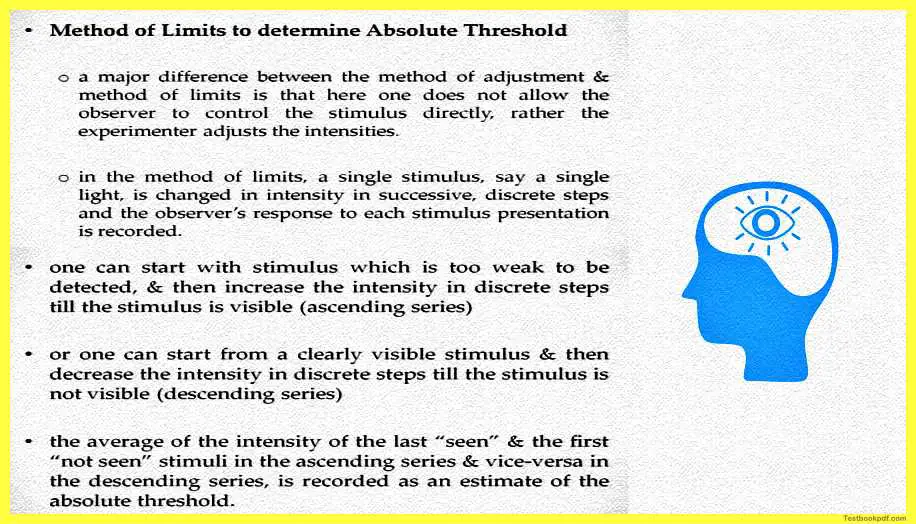
Another method to determine absolute threshold is the method of limits so a major difference by the way between the method of adjustment and the method of limits is that here one does not allow the observer to control the stimulus directly but the experimenter does it himself so if I am the experimenter and you are the participant I will have the control and I will change the dial towards the left or towards the right, and I will keep asking you the same questions did you detect it or did you not you will give me answers at particular points I will note that down and I’ll probably do the same as I did with the absolute threshold procedure I’ll probably go once in an ascending way increasing steps once in a descending way decreasing steps and I’ll take an average of those values this average of an average of the intensity of the last scene and the first not seen essentially in the sending this and descending series is then recorded as the absolute threshold.
Using the Method of Limits to Determine an Absolute Threshold
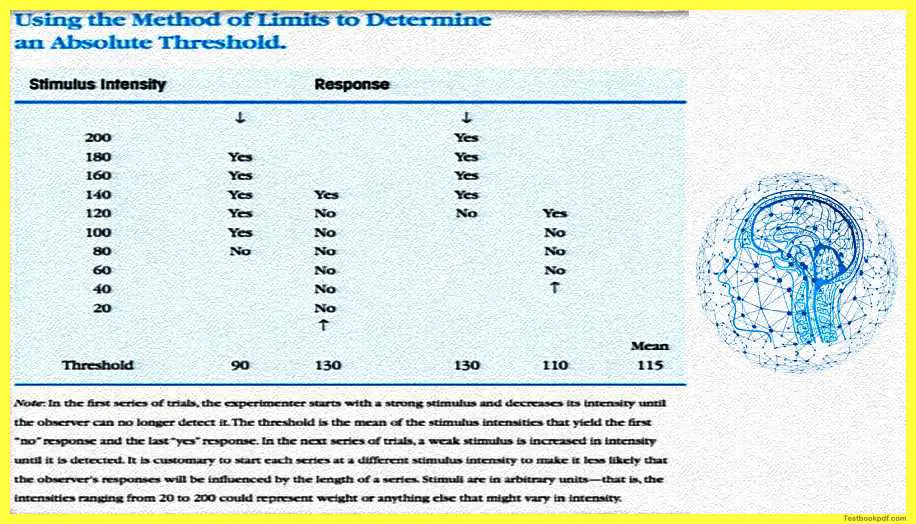
Here is an example so say for example I am talking about stimulus intensity let us say the stimulus is x I start from values starting at the very top 200 I start from 180 you say yes 160 you say yes on 140 120 100 and at 80 you say no then I start from the bottom I start from somewhere around 20 and I go up to 140 from 120 to 140 you said yes so I’ll note that value is 130. I do it again from 200 again a value comes I do it from 110 again a particular value comes all of these values are actually average and you get a mean value of 115 which is your absolute threshold.
How do you use the method of limits to determine difference thresholds the difference thresholds basically are based on relative judgments in which a constant unchanging comparison stimulus is judged related to the series of changing stories so I’ll give you one brick to hold in your hand and I’ll keep giving breaks of different weights and I’ll ask you when does the brick feel higher or lower something like that the question that is asked is how different must the two stimuli be before they can be reliably distinguished.
Methods of Limit to Determine Difference Threshold
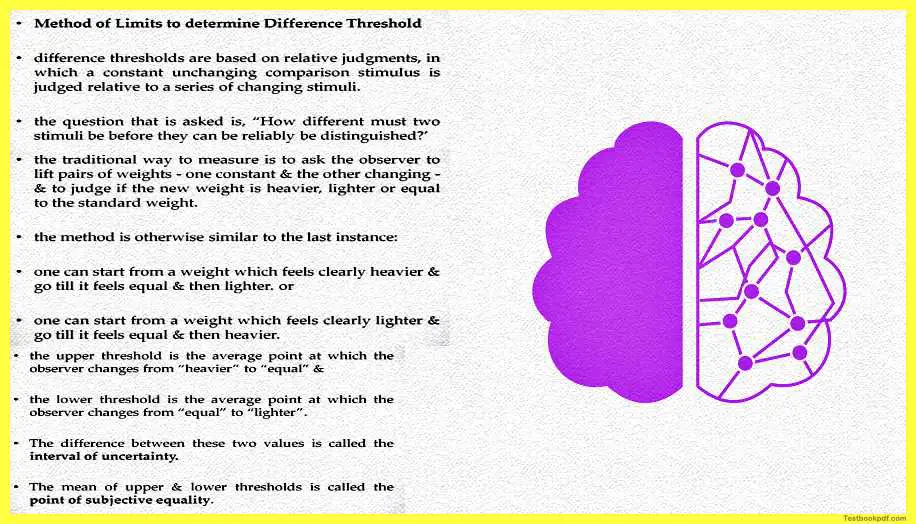
The traditional way is to measure to ask the observer lift pairs of weights as i said one is constant the other is changing and to judge if the new weight is heavier or lighter the method is otherwise similar to the last instance of method of limits or method of method of limits now one can start from a weight which feels clearly heavier much the weights of the two things are very different and go till it starts feeling slightly equal and then lighter or one can start from a weight which is much lighter and then starts feeling equal or heavier in the next step the upper threshold is the average point at the one at which the observer says it was equal and then heavier the lower threshold is when the observer says it is equal and then in the next step lighter this difference of these two values is called the interval of uncertainty the mean of these upper and lower values is called the point of subjective equality where you are thinking that you’ve got somewhere equal to this equal to the standard stimulus.
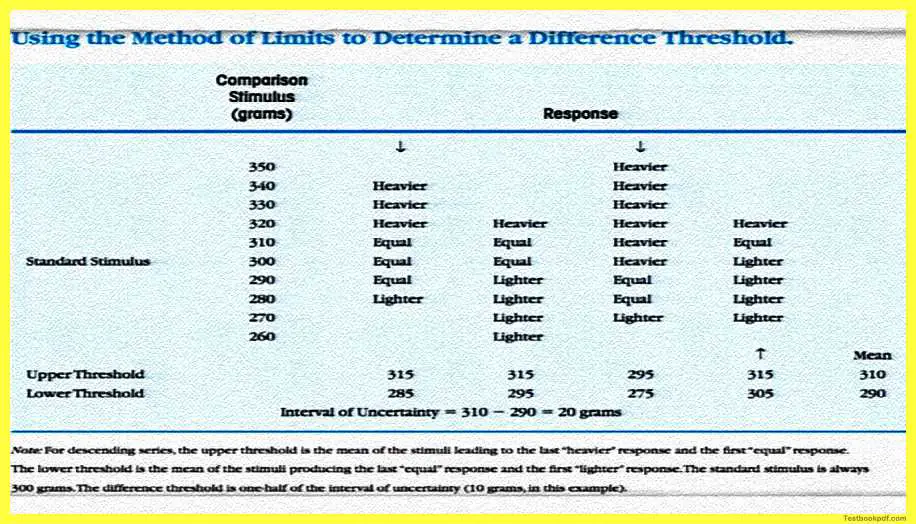
This is a demonstration so have a weight which is probably around 300 grams or so and you start from 350, 340, 330 three you find it heavier heavier heavier and 320 to ten you find it equal so the value of three the average of three twenty and three ten is three fifteen that is recorded next you start from lighter to seventy and you then go upwards then you get this value of somewhere around 315. similarly, if you do this again and again you get three-four values you take the mean of all of them.
So that is the mean of your upper threshold when you’re going in the higher series ascending series and then the lower threshold is when you’re coming down so you take the mean of the upper threshold and lower threshold and that will be your point of subjective equality now this is again one way of determining this.
Now let us move a bit further Ernst Heinrich weber basically discovered some important properties of difference threshold what did he find he found that the magnitude of the difference threshold increases with an increase in the magnitude of the standard stimulus, so you are asking you to detect the difference of a particular stimulus from a very light stimulus that is said for example 10 grams of something then.
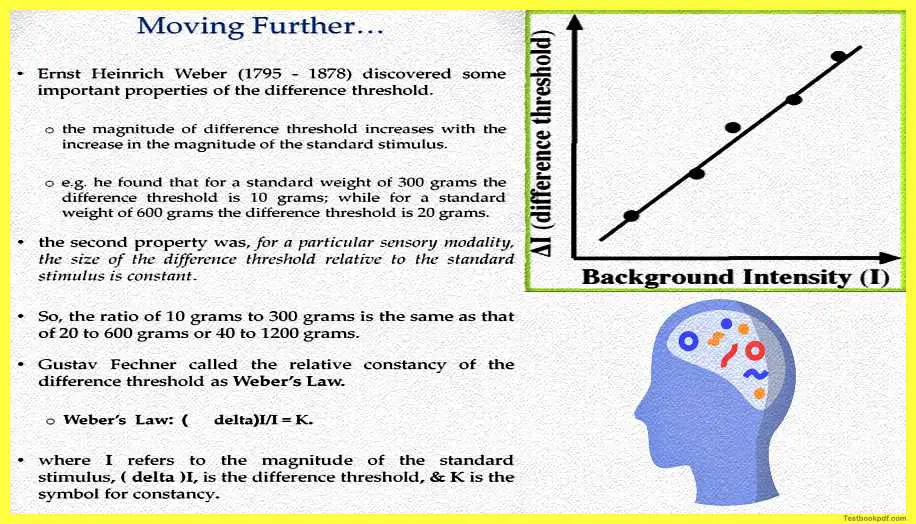
For example, if I want you to tell me whether something is heavier or not or lighter than a 300-gram stimulus and the difference threshold, will be around 10 grams if I ask you to give me the same comparison for a standard stimulus of 600 grams then the difference threshold will be around 20 grams similarly if I go to three 900 grams the difference threshold will be around 30 grams.
Now if you’ve also noticed what I’m talking about is that for a particular sensory modality the size of this difference threshold is really relative to the standard stimulus is constant so the ratio of 10 grams to 300 grams is the same as the ratio of 600 grams to 20 grams or 40 grams to 1200 so that ratio remains constant.
Gustav Fechner
Gustav Fechner gave a formula for this kind of situation and he called it weber’s law so there is this delta I divided by I which is equal to a constant that is your weber’s constant when I so here I actually refer to the magnitude of the standard stimulus delta i is your difference threshold and k is the constant now this is something which is not really going to change and you saw in the earlier examples that this is actually the case here you can see that there is this direct linear increase in the difference threshold as compared to a standard stimulus which is probably let us say background intensity or something
Weber’s law
Weber’s law or weber’s fraction basically varies in size for different senses though so it is somewhat larger for brightness than it is for heaviness weber also discovered that the value of the difference threshold is about 2% of the magnitude of the standard stimulus intensity around that value.
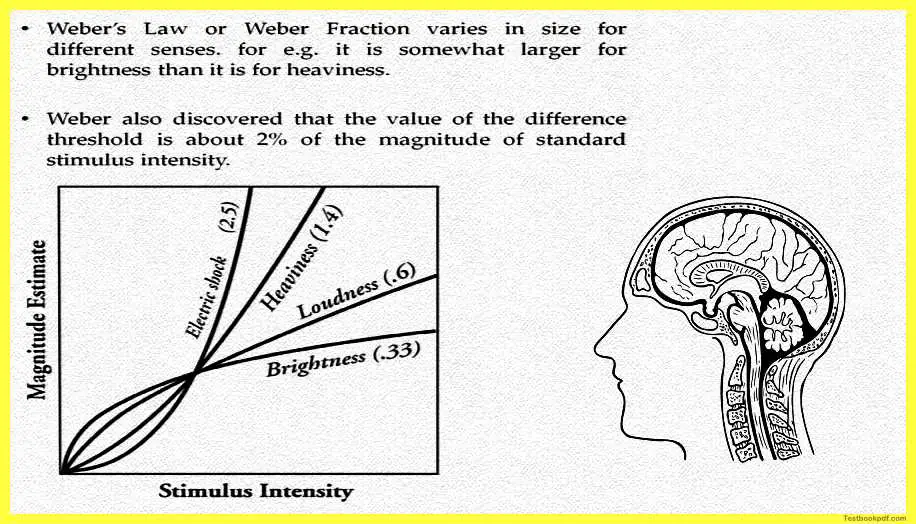
Here you can see the difference thresholds for different sensory modalities so electric similar to an electric shock the difference threshold is slightly higher for heaviness it is around 1.4 for loudness it is just 0.6 so this is something which you can see how this differentiates across different sensory modalities.
Now coming to another method the method of constant stimuli here what happens is that the experimenter chooses a number of values arbitrarily that I will give these values 5 6 7 values 9 values and on the basis of the previous explanation basically they are supposed that the threshold will lie somewhere amongst these values so let us say if I guess that the threshold for a particular stimulus will be around 10 so I will actually have all the numbers around 10 I will probably have 11, 12, 13, 14, I’ll have 9, 8, 7, 6, 5.
I’ll present these values, again and again, in this fixed set of values I’ll present them multiple times and in a quasi-random order and I will see when you can detect or you cannot detect this.
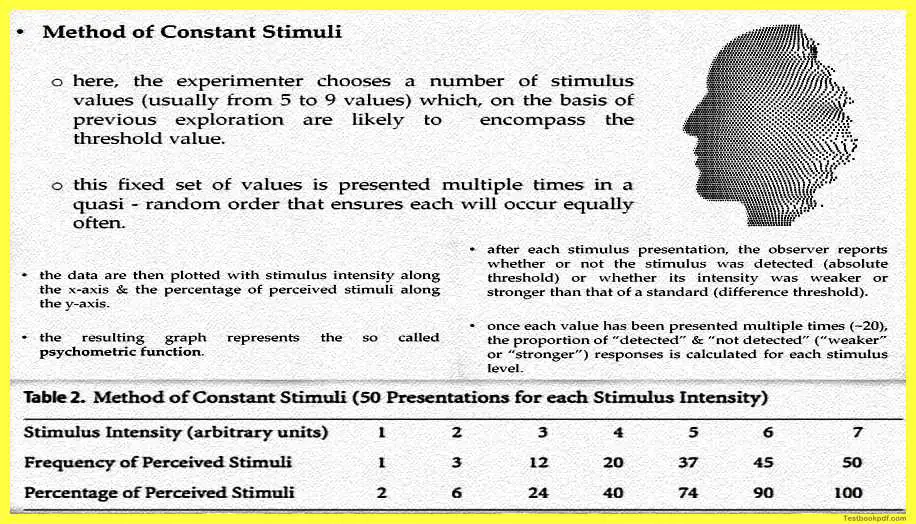
So, somewhere and after each stimulus presentation, as an observer I ask you to report whether or not you detected the stimulus or whether its intensity let us say in case of difference threshold was weaker or higher than a particular standard amount now once each value I have presented more than a particular number of times let us say 20 20 25 then what I do is the proportion of detected or not detected responses is calculated for each stimulus level so how many responses were detected at level 10 how many were detected at 12 how many were detected at 13 something like that then.
What we do is we plot this data along with stimulus intensity at the x-axis and the percentage of perceived stimuli along the y-axis this kind of function is basically called a psychometric function the psychometric function tells you around what point the subject definitely perceives a given stimulus I’ll show you how it is done.
So, for example here you have a particular stimulus let us say stimulus intensity is there that these many values 1, 2, 3, 4, 5, 6, 7 these values and then you have you presented them so many times you presented one time you presented 2, 3 times you presented 3, 12 times something like that the percentage of the perceived stimuli at all of these values is also calculated how many times the person the perceived the stimulus at level one or how many times he perceived the stimulus at level 7.
All of this is plotted in a particular graph which you can see right here you can see that the number of times the person perceived the value increases above 50 percent at around four and a bit more than four by around seven per person is perceiving the stimulus almost hundred percent of the time this is again one way of determining the point at which the person can always and hundred percent perceive a particular stimulus this is again one way of really determining the absolute threshold.
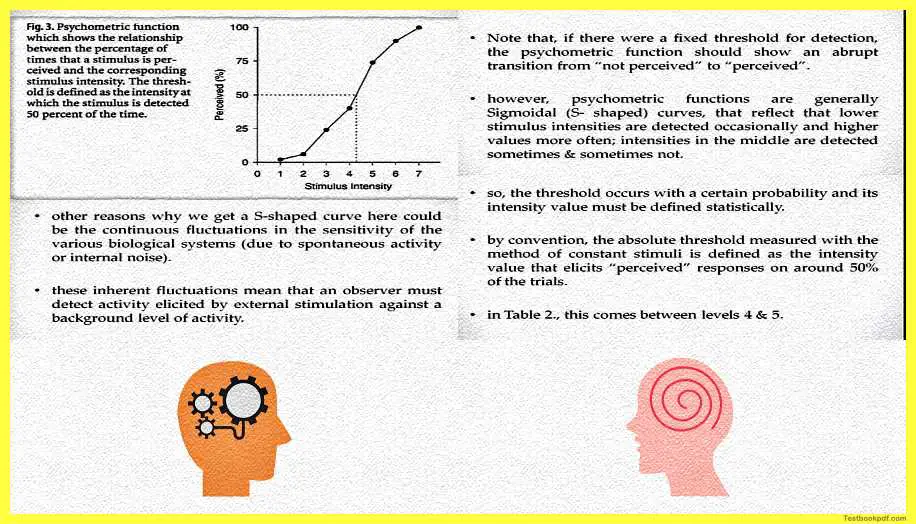
Now if you notice I am going back to this figure if you notice that this figure is slightly s-shaped it is not really a steep thing if it if say for example there was a steep difference between the absolute threshold and the not detectable value then probably it will be an abrupt change so, for example, it will probably be more a z-like thing, but it is slightly s-shaped and why is it like that.
This the psychometric functions generally are a sigmoidal or s-shaped because of the fact that lower stimulus intensities are sometimes detected occasionally higher values are detected more often and the intensities in the middle are detected sometimes and sometimes not so that 0.5 thing is always there it is detected at by chance sometimes not detected by chance at others so it does not clear distinction between the point where you cannot certainly detect a stimulus and where you can certainly detect a stimulus other reasons why you could get an s-shaped curved in these kind of functions is probably because there is always continuous fluctuation in the sensitivity of various systems say for example the amount of information or the discreteness with which your ear is registering the loudness information also can have a bit of a fluctuation due to spontaneous internal noise and stuff like that you’re thinking of something your attention is varied a little bit all of these kind of factors.
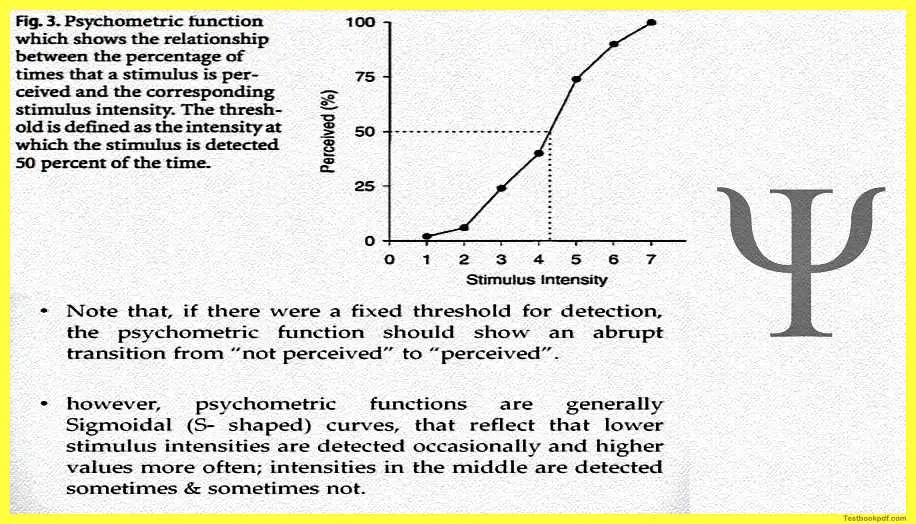
These inherent fluctuations mean that an observer must detect an activity elicited by an external stimulation against the background level affected so for example if you’re trying to listen to a bird and you’re sitting in a park what you’re trying to do is you’re trying to detect that particular signal from so much of background noise that is already going on, in that case, your psychometric function will never be a step function will always be a sigmoidal s-shaped curve.
So the threshold occurs with a certain probability and its intensity value then must need to be defined in a statistical way by convention absolute threshold is define measured got with a method of constant stimuli and is defined as the intensity value that elicits perceived responses around 50 percent of the trials so if just above 50 you can detect something that is pretty much what your absolute threshold will be.
Staircase Method
So, in table 2 which you just saw you can see that this value lies somewhere between 4 and five make sense another method you can use to determine the absolute threshold is the staircase method which is the stickiest method it is an adaptive testing procedure basically used to keep the test stimuli close to the threshold drain so, for example, you have a good idea of what the threshold might be so what you do is you follow a staircase kind of a thing so you take hold of some values and you actually present these a very small range of four five six values again and again to the participant you ask him that whether you detected this stimulus or you didn’t detect the similarities.
Every time the person gives a response you change the value so a small smaller range of values is there and this is a rather efficient way of doing it because you are not doing a testing hundred times this is therefore called the staircase method I will show you how it is done so an observer we can start from an ascending series or a descending series each time the user is saying yes you change this intensity just by one step this continues until the stimulus becomes too weak to be detected.
In a descending series in an ascending when it becomes detected finally at this point so you reverse the direction you continue the response till the person says yes now I detect it or if you are coming from the other direction you do it till the batsman says no so you keep alternating this direction.
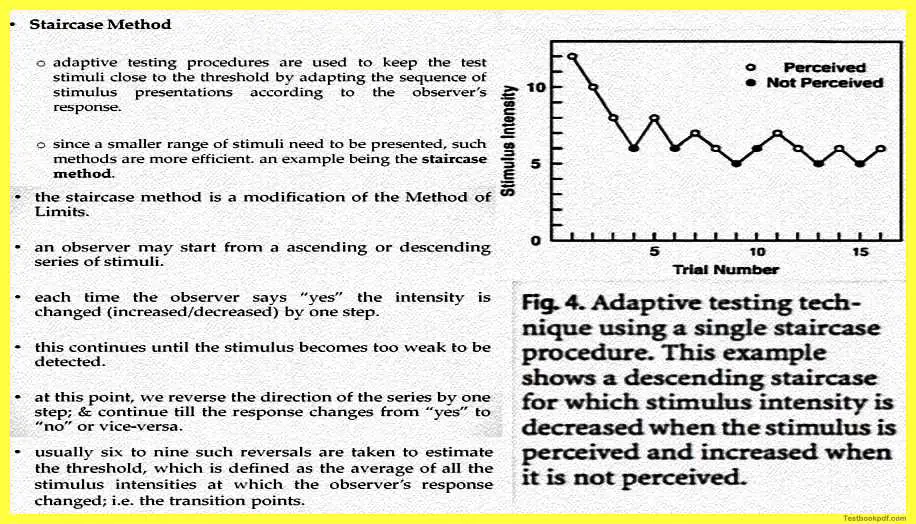
Usually, after 6 to 9 such kinds of reversals in the direction, you’re actually good at estimating the threshold now the threshold here is divided as the average of all the stimulus intensities that you presented at which the observer’s response changed from yes to no or from you to the node to yes and these different points are called transition points I’ll show you how it is done.
Say for example in this figure you can see that you can start from high intensity to a point when the observer’s response goes to not perceive then you again go one step further observer says perceived you come back when the observer again says not perceived and you do this a particular number of times you just take the average of this eventually and that becomes your threshold.
At the End
Now to sum up what did we talk about today we talked about the concept of sensation versus perception what is the sensation is a part of what is perception it is a constructive process through which we actually make use of whatever sensory input we’re getting from the world we also talked about how using psychophysics you can actually put numbers to the subjective experiences we also talked about a variety of methods using within psychophysics that are used to determine these thresholds of experience both absolute thresholds and difference thresholds thank you.
Read also:
Sensation and Perception Psychology Pdf
Research Methods in Cognitive Psychology Pdf (PET fMRI ERP)
Click here for Complete Psychology Teaching Study Material in Hindi – Lets Learn Squad
